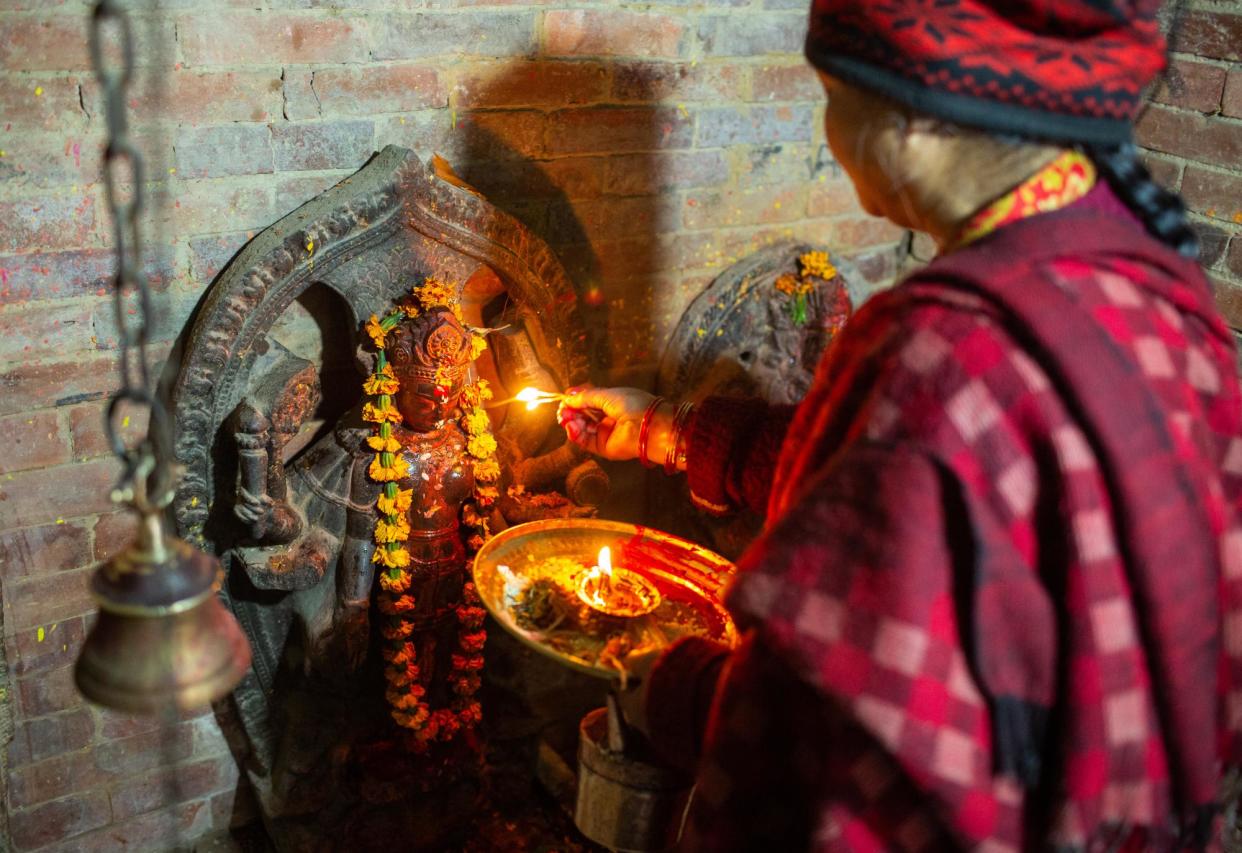‘Our god was locked in a US museum’: the heritage hunters bringing home Nepal’s lost treasures

Flicking through a newspaper in 2020, Sanjay Adhikari read a story that changed the direction of his life – a Nepalese statue of gods Laxmi and Narayan, was on display at the Dallas Museum of Art. “I could not sleep. Our god was locked inside a museum in the US,” he says.
Adhikari, from Kathmandu, spoke to conservationists, activists, journalists and museum curators, and launched a campaign to see the 10th-century statue returned to Nepal.
“I wrote dozens of emails to the foreign ministry, archaeology department and the US embassy,” he says. The 28-year-old got the mayor of Lalitpur town, in Kathmandu valley, to file a police report about the missing statue, and spoke to priests at Patko Tole temple, from where it was taken 40 years ago. He sent all the documents to the Nepalese and US authorities.
In 2021, the statue was brought home and reinstalled at the temple.
Sanjay Adhikari in front of the Laxmi Narayan Temple in Lalitpur. Adhikari helped recover the temple’s main statue of the god and goddess from the US
Thousands of centuries-old artefacts have been looted since Nepal opened up to international trade and tourism in the 1950s. Objects have turned up in museums and auction halls in the US, Europe and Asia.
They should know that these arts are not made to be showcased. They were made for worship
Sanjay Adhikari
“Kathmandu valley was an open museum,” says Rohit Ranjitkar, director of the Kathmandu Valley Preservation Trust. “There were arts everywhere. Besides temples or monuments, there were centuries-old treasures. I think the local people did not value it or there was less awareness. So many things were knowingly or unknowingly gifted or thrown out or sold by local people.”
The past few years has seen a concerted effort by Nepali heritage hunters to get these objects back where they belong, helped by the changing attitudes of western governments and institutions, which have become more willing to return disputed artefacts.
Shrestha placing offerings at the base of a statue at the temple of Laxmi Narayan. Historic statues are now often protected behind bars
Buoyed up by his success, Adhikari launched the Nepal Heritage Recovery Campaign (NHRC) and, as one of the country’s leading heritage lawyers now, has helped to recover about 30 pieces of art. These include a 10th-century stone figure of Uma Maheswar from Denver Art Museum and a stone panel of Shiva from the ninth or 10th century from the Metropolitan Museum of Art in New York. He helped stop an auction of five gilded bronze 16th-century Nepali figures in Paris and the sale of a Buddha statue in Hong Kong, which had an auction guide price of at least 1.5m yuan (£166,000).
Adhikari at the 17th-century carved sunken Tusha Hiti watertank at Sundari Chock in Patan. The waterspout is a replica, made after the original was removed in 2010. Now recovered, it is in the National Museum of Nepal in Chhauni, Kathmandu
The NHRC is working on the return of another 120 objects. The Lost Arts of Nepal, launched in 2015 by an anonymous activist to preserve ancient buildings damaged by a devastating earthquake, has played a key role in tracking down artefacts. The group believes more than 100,000 Nepalese treasures, including sculptures, paintings, manuscripts, and jewellery, are “scattered around the world in museums and private collections”.
It is “a job the government should be doing”, says the activist. When artefacts are identified, details are passed on to Adhikari, who prepares legal documentation to get them back.
The stone head of Saraswati, recovered from the US in 1999 and now on display in the National Museum of Nepal as part of a temporary exhibition of repatriated heritage
Saubhagya Pradhananga is director general of the government’s department of archaeology. She has “limited resources” and applauds the NHRC and Lost Arts. “It’s because of an aggressive campaign by the civil society, and access to social media and awareness in young people,” she says.
Saubhagya Pradhananga, director of the government department of archaeology
“It is essential to our country that all the arts return to Nepal as soon as possible because they are our gods and they have the belief of millions of people. It is important to carry forward our culture and heritage,” says Pradhananga. “This art is not for showcasing in a museum and to buy or sell. We created it to live with it.”
Adhikari has written to the British Museum asking for the return of a missing 12th-century Uma Maheswar stone statue which he says disappeared from Nepal in the late 1960s.
He is also working to retrieve a 17th-century Taleju necklace on display at the Art Institute of Chicago which was loaned to the museum in 1976 by a Chicago art institution.
A 15th-century wooden statue of Nritya Devi from the I Baha Bahi Buddhist monastery in Patan. It was repatriated from the US and is now part of the temporary exhibition at the national museum
The NHRC is urging western museums to go through their collections and return items with dubious origins.
“The problem is, the museums ask us to provide evidence [of ownership from Nepal], which is not always easy to find. These things are centuries old and evidence might have been stolen or distorted already,” says Adhikari.
“Why don’t they just return it? They should know that these arts are not made to be showcased. They were made for worship. They belong to Nepali people.”


